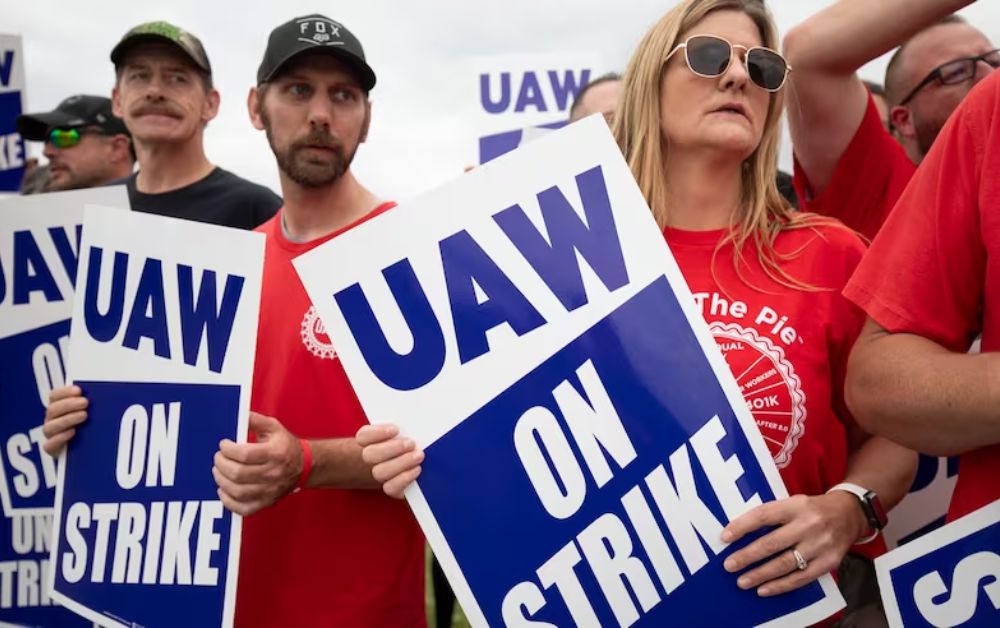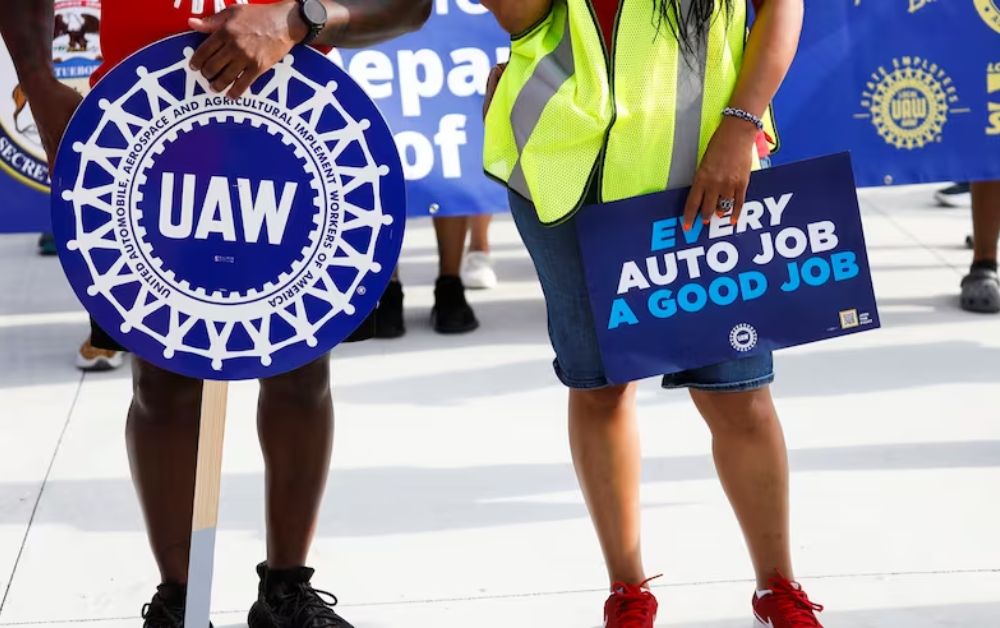UAW Workers Strike Resolved with Tentative Agreements at GM, Ford, and Stellantis: Key Insights

The UAW Strike Is Over – A Summary
As of October 30, the United Auto Workers (UAW) coordinated strike has come to a close, with the UAW reaching tentative agreements with General Motors (GM), Ford, and Stellantis (formerly Fiat Chrysler). This strike had significant implications beyond the automotive industry, affecting various aspects of daily life.

Updates on the Strike
October 30: A tentative deal with GM has been reached, alongside previously announced agreements with Ford and Stellantis. However, specific details of the GM agreement are not immediately available.
October 25: Ford announced a tentative agreement with UAW, subject to ratification by its UAW-represented employees, while negotiations with Stellantis and General Motors were ongoing.
October 24: The strike escalated with the shutdown of Stellantis’ Ram 1500 production facility, followed by 5,000 workers walking out at the General Motors plant in Arlington, Texas, impacting the production of popular full-size SUVs. GM reported solid earnings despite strike-related setbacks, contributing to the UAW’s continued focus on securing favorable contracts.
October 23: A surprise strike at Ram’s Sterling Heights facility in Michigan further challenged Stellantis, as the UAW aimed to improve its contract terms with the company, particularly in terms of compensation and worker status conversion.
October 20: As the strike entered its sixth week, GM, Ford, and Stellantis offered substantial wage increases and other benefits, such as cost-of-living adjustments and retirement contributions, to UAW members. Despite these attractive offers, UAW President Shawn Fain sought more substantial gains, while avoiding further plant strikes.

Impact of the Strike
Over 34,000 UAW members went on strike, causing ripple effects, including layoffs among automakers and suppliers. Stellantis withdrew from major auto shows, and Ford halted construction of a battery plant in Michigan.
October 13: The UAW adopted a more dynamic approach to the strike, launching unexpected actions at key Ford, GM, and Stellantis plants. Despite company claims of generous offers, UAW members continued to picket, leading to more layoffs.
Canadian Strike:
About 4,300 Canadian auto workers went on strike at GM facilities after failing to reach a tentative agreement. The strike affected the production of Silverado pickups, engines, and a stamping plant.
October 6: Last-minute negotiations prevented a strike at GM’s profitable Arlington, Texas, plant. This outcome was secured by agreeing to include battery plant workers in the upcoming contract.
September 29: The strike expanded to more Ford and GM employees from assembly plants, impacting various vehicle production lines. Stellantis narrowly avoided further action after significant bargaining efforts.
September 22: UAW called for strikes at GM and Stellantis parts distribution centers in several states, affecting repair services. This “Stand Up” strategy aimed to keep companies off balance in the pursuit of favorable contracts.

Understanding the UAW Strike
The strike is part of a broader trend of labor actions across different industries, with the UAW seeking leverage in negotiations with GM, Ford, and Stellantis.
Locations of Strikes: The strikes affected specific plants at Ford, Stellantis, and GM, with workers demanding better compensation and benefits.
Main Issues: Wage increases, cost-of-living adjustments, full pay for new hires, and improved benefits were key demands from the UAW. The companies emphasized the need for competitiveness with non-unionized plants.
Unique Negotiations: New leadership at the bargaining table, industry shifts towards electric vehicles (EVs), and growing support for unions have created a distinctive negotiating environment.
Potential Impact: While short-term price increases and vehicle availability issues are possible, the strike’s long-term consequences may include higher car prices and production delays.
Economic Consequences: Even a 10-day strike could result in an economic loss exceeding $5 billion, impacting key car-making states like Michigan and potentially triggering a recession.
The UAW strike had far-reaching implications, affecting not only the automotive industry but also various aspects of daily life, underscoring the importance of labor negotiations in a global economy.
Conclusion
In conclusion, the UAW workers’ strike, which spanned several weeks and involved major automotive companies like GM, Ford, and Stellantis, was a pivotal moment in the ongoing negotiations between the labor union and automakers. This strike not only highlighted the challenges and demands faced by the UAW members but also shed light on the evolving landscape of the automotive industry as it grapples with the transition to electric vehicles and changing consumer preferences.
The UAW’s unwavering commitment to securing favorable contracts for its members, including substantial wage increases and improved benefits, showcased the determination of the American workforce to be fairly compensated for their contributions to these corporate giants. The strikes were not limited to the picket lines; they had broader economic consequences, with potential impacts on car prices, availability, and even the risk of recession in key manufacturing states.
This labor dispute also revealed the changing dynamics within the industry, where the introduction of new faces at the bargaining table, coupled with political pressures and societal support for unions, created a unique negotiation environment. The UAW strike served as a testament to the collective bargaining power of workers and their growing recognition in a world increasingly focused on labor rights and fair compensation.
As we move forward, the outcomes of these negotiations will undoubtedly affect the automotive industry, the workforce, and consumers alike. Whether in terms of car prices, job stability, or the speed of transitioning to electric vehicles, the consequences of this strike will continue to reverberate through the industry for years to come. It underscores the importance of fair labor practices, the critical role of unions, and the evolving nature of the automotive sector in a changing world.
Related Articles

Driving Relief: Ontario Gas Tax Reduction Extended Amid Economic Challenges
Premier Doug Ford has announced the extension of Ontario’s gas tax reduction until the end of the year, a decision poised to provide much-needed relief to drivers across the province. As the government gears up to unveil its budget, the emphasis on cost containment and support for motorists underscores a commitment to alleviating financial strains and fostering economic resilience in Ontario.

2025 Audi A3 Sedan: Unveiling Subtle Updates and Customizable Features
Today, we delve into the world of Audi with an exclusive look at the anticipated 2025 Audi A3 Sedan. Set to make waves in the North American market with its subtle yet captivating refresh, this sedan embodies Audi’s commitment to innovation and style. Join us as we explore the intricate details and unique features of this highly anticipated release.

Jeep Price Drop Signals Brand Transition Ahead of EV Launches
As Jeep gears up for a monumental shift in its lineup with the impending launch of its first electric vehicles (EVs), the brand is making significant moves to adapt. One notable change is the price drop on two of its popular models, the Compass and Grand Cherokee. Let’s delve into the details of this transition and what it means for Jeep enthusiasts and the broader automotive market.

When Does Drive to Survive Come Out?
The highly anticipated new season of “Drive to Survive” is just around the corner, set to hit screens on February 23. With its captivating portrayal of the high-stakes world of Formula 1, this Netflix docuseries has become an absolute must-watch for racing aficionados worldwide.




